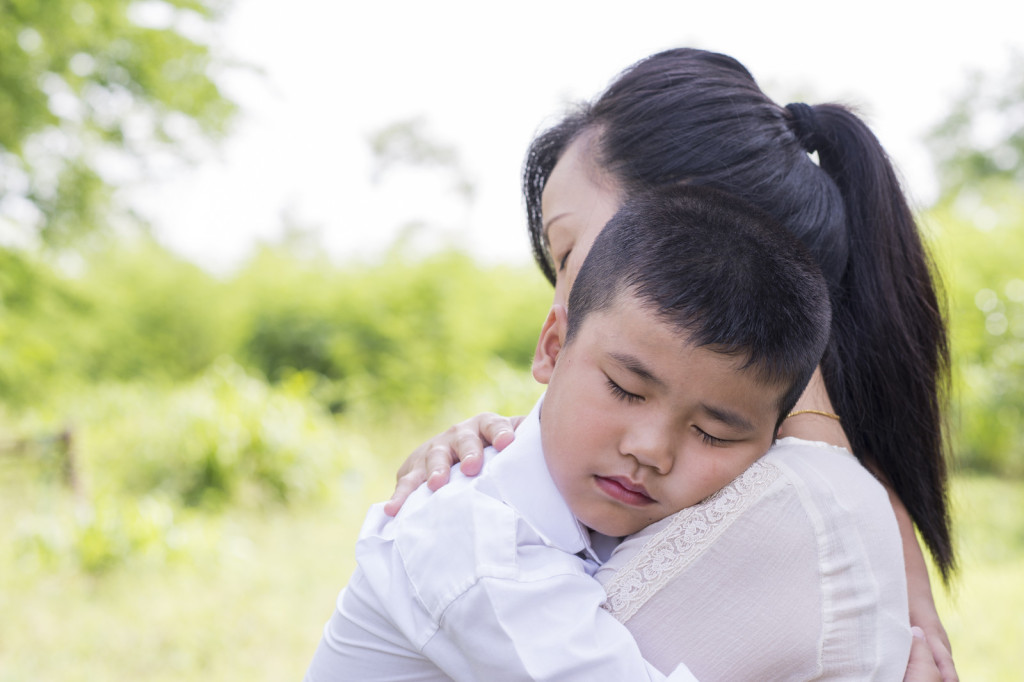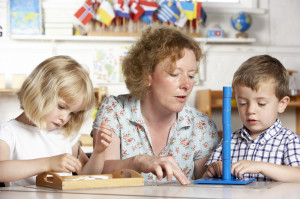Maintaining effective communication with their child is a common struggle for parents. The way adults tend to talk about their daily lives and the problems they’re dealing with doesn’t seem to translate well to a conversation with a 3rd grader. Parents naturally want to help their child handle problems, and it can be frustrating when the parent doesn’t fully understand these problems. Without an understanding, it is impossible to really help.
Luckily, psychologists have found a general trend to psychological development that all children go through. Some researchers noticed that there are ‘stages’ of life and these stages will present a certain problem for everyone at that age (regardless of the individual’s culture). Erik Erikson’s Stages of Psychosocial Development consist of 7 stages, 3 of which occur during the school ages. In each stage, a serious life decision or life-view is developed. This experience is usually something that the individual thinks about every day during the years that they are in the life stage, and each stage has a positive and negative outcome. Having a strong understanding of these life stages can help parents understand the struggles that their children are going through, and give them guidance on how to help their children face those challenges.
- Stage One (birth – 2 years old) is the development of trust. If parents comfort the child when they cry, the child learns that it can trust it’s caregivers to be there.
- Stage Two (2 – 4) is the development of autonomy or self-will. Here, the child discovers that it has the ability to choose what actions it will take, such as deciding when it is done eating and ready to resume play.
- Stage Three (4 – 6) is the development of initiative or direction. This is when the child develops the understanding of how the world around them operates.
- Stage Four (6 – 12) is the development of self-direction, where the child learns how they can influence the world they are in. If the child is constantly falling short of expectations, they will instead develop a prevailing feeling of inferiority to their peers.
- Stage Five (12 – 19) is when children become adolescents, and develop an understanding of their own identity, who they will be in the world. Until they develop this identity, they will find themselves in a constant state of identity confusion.
- Stages Six and Seven occur after a person is finished with school, so we will not discuss them here.
Now we’ll look at the stages which will be particularly relevant to parents seeking to understand their school-age children.
Stage Three, The “Play Age” (Ages 3 – 6)
In this stage, children discover the boundaries of the world and what it can do. This encompasses many activities: physical, verbal, cognitive, and emotional. Children spend these years finding out how simple matters like gravity, colors, and interpersonal interactions work. Children in this stage will be interested by concepts like numbers and time (and clocks, consequently). It is common for children to show some apprehension when discovering something new, sometimes looking to their parents questioningly to see if they can venture further. Yet through this period of exploring and learning, children learn courage and independence.
A common issue experienced by children in this stage is frustration, because they are developing understanding, not always as quickly as they’d like. They may have a desire to do something, but do not understand how to realize their desired outcome. Suppose a child sees how their friends build a tower with blocks. Because the child doesn’t have a full understanding of balance, their attempts at a similar tower continue to topple over. The child becomes upset with their inability to achieve something that they know is possible. If this continues, the frustration may evolve into a tantrum.
The caregiver can help the child through this development by helping them understand how things work. Also, it is possible to turn the bad into good. The caregiver could purposely build towers to fall over, to show the child that the tumbling can be fun as well. Eventually, the child will find where to position blocks that will remain sturdy. For a more detailed look at toddler frustration, including tips on catching it early, see this article.
Many of the activities pursued by children this age may seem silly or illogical to adults. To help your child through this stage, parents should be patient, letting the child know what is alright to explore, and helping along where possible. Conversely, when the child is exploring something that is not safe to explore (like an in-use oven or Dad’s tool shed), the parent should not prohibit the child, but rather guide them to an understanding of why something is dangerous. Proper handling can make the danger into something productive.
Furthermore, children who desire to explore their environment and are repeatedly denied the opportunity may develop feelings of guilt. They may believe that they are denied from exploring because they should not want to explore (constant denying by parents and teachers can have this effect), but their desires spur them on. This disparity causes feelings of guilt, which the young child will not likely be able to explain to adults.
 Stage Four, Industry Vs. Inferiority (Ages 6 – 12)
Stage Four, Industry Vs. Inferiority (Ages 6 – 12)
After developing a basic understanding of how the world around them operates, children begin to consider how they fit into that world. In Stage Four, children will become eager to learn how to read and write, as they start to realize that these skills are necessary to interact with the world around them. Building upon their knowledge of their ability to make objects move and express emotions using their words, children will now realize that they can do these things strategically to achieve certain ends. Hence, lying may become more prominent here. On the other hand, children will enjoy seeing their actions having a positive impact on the people in their lives. This is why they enjoy having their drawings and schoolwork displayed on the fridge.
The major issue that can arise during this stage is an inferiority complex. If children receive a great deal of criticism towards their work, or even if they have a lack of any feedback, positive or negative, they will develop a view of themselves as being unable to successfully work within the world. Parents should take care to avoid commenting on negative aspects of their child’s work. Of course, children are rarely proficient at anything during these years, but if parents compliment the quality aspects of what their child does, the child will revel in their success. Seeking more success (and the resultant praise), the child will naturally seek to improve their work. Parents can assist improvements by carefully wording constructive criticism. “You did a great job building that tower; let’s see if we can build another!” would be a good way to lead with praise, then follow up with a challenge that doesn’t indicate inferiority. In many sentences, replacing ‘but’ with ‘and’ can turn ridicule to praise. This will keep the child interested in developing their skills. Naturally, parents may worry that they are spoiling their children with too much praise. See this article to learn more about walking the fine line of positive feedback.
 Stage Five, Identity Formation Vs. Confusion (Ages 12 – 19)
Stage Five, Identity Formation Vs. Confusion (Ages 12 – 19)
This final school-age stage is perhaps most commonly dreaded by parents, and is the basis for many a coming-of-age movie. Erickson’s Fifth Stage of Identity Formation focuses on the individual finding how they are truly unique, as well as finding how they fit into a social group. During this stage, individuals try different groups and affiliations (social, religious, political) to see which groups that can feel a belonging to. In doing this, they develop an idea of who they are and where they are headed in life. Therefore, they also develop an idea of what school and career they would like to pursue.
The confusion of this stage leads to many negative outcomes: frustration, depression, and anger. Because of the desire to seem independent, many teens will repel their parents’ attempts to help. Perhaps the best way to break through this barrier is to ensure your child that you are always available to talk, judgement free. Eventually, the pressure builds up and your child will need someone to vent to. Make sure not to react negatively to what they tell you: doing so will teach them that they can’t trust you to be empathetic to their problems. When they are done talking, ask questions such as “do you think this lifestyle will make you happy in the future?” and “I know these kids are cool now. What do you think they will be like when they’re 30?” to help them start thinking about the consequences of certain social groups.
While it may be frustrating to be non-confrontational, remember that confrontation generally causes the other party (the teenager) to become defensive, and then any advice will probably be ignored. For a very brief overview of aiding a teenager through teenage trials, see this article from PBS. Since this stage is one of the most turbulent, this article just scratches the surface. The most caring parents may also seek out resources more tailored to the problems their teenager is facing.
Conclusion
The stages of psychological development that children go through present very real issues of concern to them. It may seem silly to an adult that their child is experiencing a personal conflict in some of these stages, but all adults went through these stages at some point as well. Try to understand the world from your child’s eyes to see how daunting these issues can be for them.
It is worthwhile to point out that the stage of psychological development experienced from ages 26 to ~64 is called ‘Generativity vs. Stagnation’; adults desire the sense that they are caring for the next generation and passing on life lessons in a way that will make life better for those that they care for. Caring for your own children in this way is one of the most important ways to prove your own generativity to yourself.
Some children, particularly those aged twelve and up, may reject advice from their parents. You can use your past experiences to build a bridge. Remember what happened when you were in your child’s stage of psychological development. Sure, times have changed, but the way people experience these stages is still the same, and relating your experiences can help your children see that you can help them in their experiences.
Summing Up
-Erikson’s Stages of Psychosocial Development can help us understand the struggles children are going through
-Children ages 3 – 6 are concerned with discovering how the world works. Make sure to encourage their exploration. This will help them develop courage and curiosity.
-Children ages 6 to 12 are figuring out how to operate in the world. Parents should encourage children by praising positive outcomes in school, relationships, and life. Too little praise could have the children feeling like they are unskilled in necessary life skills.
-Teenagers are concerned with finding their identity, and will likely spend time with different groups and affiliations. Give them time in these ‘phases’, and help them discover for themselves what fits them best.
-Negative feedback is rarely helpful in any stage. Open communication about what the child is feeling and positive feedback on what they do correctly will encourage them to push forward to find what they are good at and what is good for them.
-Remember that you’ve been there too! Relating your experiences to your child can help build a bridge and show them that what they are going through is natural.
Matthew Rottmann is a tutor for General Academic and a student of Psychology and Business. He has a passion using Psychology to make school and work more productive and enjoyable for people, and is working towards a career in business consulting.




























Pingback: Why Do Teens Always Seem So Angry?